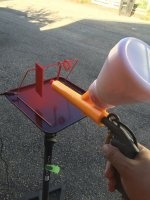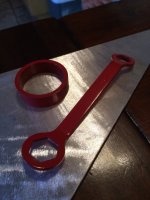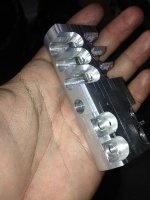Thanks
@Janger,
$100 isn't bad at all!
With regard to the machining, thanks! I have sunk a handful of hours into this little guy. Learned alot as always.
This is based off of a design that is not mine originally, but I did modify the original design to reduce amount of stress put on the brake, as well as increased the sidewall thicknesses.
With regard to usage and safety, I would be lying to you if I told you I wasn't planning on using this on my rifle, but I want to assure you that the risks involved with this particular project are well known.
The involved risk is no greater than usual when out shooting at the range.
It's pretty safe as long as you follow standard gun safety rules, but I totally understand and will not push if you choose not to help in this case, all good!
Aluminum is a pretty common material for Muzzle brakes, as is steel.
Muzzle brakes have two typical failure modes that can come about from poor engineering or machining
The first is the bullet hitting the inside of the brake as it passes through.
(example)
This causes your bullet to fly off of the side by a large margin, sometimes even
keyhole (tumble in flight). Either way it's a loss in accuracy we're talking about here.
Here's some guys talking about it, as I couldn't find an article -->
http://www.theakforum.net/forums/14-general-discussion/67967-if-bullet-hits-muzzle-break.html
The other common failure is the brake slipping off of the gun due to damaged threads, or poor clamping, or a bullet really "striking" the brake.
(skip to 0:35 - He noticed the slip before sending it down range)
(skip to 2:00 - Sent his down range)
In both of the above failure modes, there is risk of being struck with the brake or pieces of the brake, or a stray bullet,
but only if you are down range of the gun!
(To be clear, you never stand downrange of an shooter preparing a shot, and you never shoot when someone is down range. This is standard gun safety)
Even with an aluminum block right on the end of the gun in the path of the bullet, all of the force involved is headed down range. (Here's a new police gadget that does just this:
http://www.alternativeballistics.com/)
So really, pretty safe (No more dangerous then regular target shooting anyways!)
It's interesting, in the US
hobbiest gunsmithing is a thriving branch of hobby machining. So fortunately the science and failure of most of this stuff is pretty well understood.

As with all hobbyist gunsmithing the first shots are done in a control environment with appropriate safeties put in place just in case. (This is for safety, but also to get the gun re-sighted to keep accurate after you make changes)
I would just buy one, but the cost is exorbitant.
--> In the states you can buy muzzle brakes for $10 from discount stores, and though I am not speaking to their safety standards, I'm pretty confident I put more thought into my design, haha.
Here's a good example of 3.4 oz (96 grams) of aluminum (Sold for $80USD south of the border) listed for $330!!, here in Calgary at wholesale sports.
http://screencast.com/t/L0bA6pULtlX
That's like, $1100 per pound of aluminum if you buy a muzzle brake, vs making one.
Anyways, let me know if you're open to showing me your powder coat setup with my muzzle brake! Really, no worries if not though, I respect the decision either way.
Should we start a thread to chat about safety, ethics, and responsability around metal working? Probably get a good conversation going.
JW





